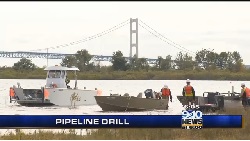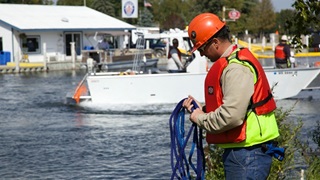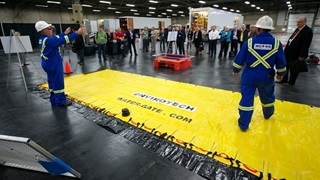Putting our incident response readiness to the test
Enbridge participates in multi-agency drill in Michigan's Straits of Mackinac
Does practice make perfect? That’s something we never want to find out.
As much as we focus on prevention to keep our pipelines safe at Enbridge, we maintain strong emergency preparedness and response capabilities.
That’s the reason we were out on Michigan’s Straits of Mackinac on Thursday – testing our emergency response plans alongside the U.S. Coast Guard, the U.S. Environmental Protection Agency, state agencies and local first responders, as part of an Enbridge Enterprise Emergency Response Team (E3RT) simulation exercise.

WATCH: TV news coverage of Enbridge's emergency response simulation drill on the Straits of Mackinac.
Thursday’s event at St. Ignace, Michigan – one among hundreds of simulation drills and exercises we hold each year across our company – also included an equipment demonstration and a VIP/media tour.
“The way we think of our emergency response capability,” Enbridge president and CEO Al Monaco told assembled media and VIPs, “is the last line of defense, like your car insurance policy. We have to have it. We make sure we maintain it. We don’t go cheap on it. But we hope we never need it.
“We want our E3RT unit to be the best-trained, best-prepared – a ready-for-anything capability – but we also want it to be the least-used team at Enbridge.”
With several hundred participants, 24 response boats including the U.S. Coast Guard cutter Alder, three helicopters and nearly 5,000 feet of boom, Thursday’s exercise simulated a three-minute incident that released 4,500 barrels of light crude oil.
(UPDATE: While in Michigan, Enbridge president and CEO Al Monaco addressed the Northern Michigan Regional Chamber Alliance on Friday, Sept. 25, 2015 at Boyne Falls, Mich. Click on this link to read news coverage of Mr. Monaco's presentation.)
With the U.S. Coast Guard in charge, and officials from the U.S. Department of Transportation’s Pipeline and Hazardous Materials Safety Administration (PHMSA), and Michigan’s Departments of Environmental Quality and Natural Resources involved, Thursday’s drill tested emergency response readiness in the areas of shoreline protection and cleanup, air monitoring, and wildlife recovery.
The overall objective? To test our tactical emergency response plan, learn from the experiences, and strengthen our capabilities.
“I think they demonstrated good presence out there,” said Ed Golder, of the Michigan Department of Natural Resources, as quoted by WOOD TV8. “That doesn’t mean we don’t have to be vigilant. We do.”
Nearly 100 VIPs witnessed Thursday’s exercise in action, including representatives from government, including staffs of Sen. Debbie Stabenow and Congressman Dan Benishek; regulatory bodies including the EPA and the Michigan Public Service Commission; industry; Native American groups; and environmental organizations. The media tour drew reporters from regional TV, radio, newspaper, and online media outlets.
“There’s things we can control and there’s things we can’t control,” said Michigan DEQ communications director Brad Wurfel, as quoted by 9&10 News. “One of the things we can control is being prepared.”
Enbridge spent $74 million on emergency response equipment and training, company-wide, between 2012 and 2014. We also held 371 drills, exercises, and equipment deployment events across our company in 2014.
“Trust needs to be earned and it needs to be built over time,” Brad Shamla, our Vice President of U.S. Pipeline Operations, told media outlets. “These exercises go a long way to establish that trust.”










